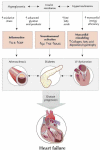Glucose, obesity, metabolic syndrome, and diabetes relevance to incidence of heart failure
- PMID: 20117431
- PMCID: PMC2834416
- DOI: 10.1016/j.jacc.2009.07.029
Glucose, obesity, metabolic syndrome, and diabetes relevance to incidence of heart failure
Abstract
Heart failure (HF) is common, results in poor clinical outcomes, and is associated with large health care costs. The incidence of HF continues to rise, with approximately 670,000 new cases per year and a 20% lifetime risk of HF for persons 40 years and older in the U.S. Risk factors for HF have been identified, and thus preventative strategies should have a positive effect on disease burden, morbidity, and mortality. Although coronary artery disease and hypertension have traditionally been considered among the most important modifiable risk factors for the development of HF, recent studies have highlighted the importance of increasingly prevalent metabolic risk factors: glucose, diabetes, obesity, and the metabolic syndrome. This report will present evidence for the link between glucose, diabetes, obesity, metabolic syndrome, and incident HF. Furthermore, we will discuss how risk factor modification and other preventive therapies may help curb the rising incidence of HF.
Copyright (c) 2010 American College of Cardiology Foundation. Published by Elsevier Inc. All rights reserved.
Figures




References
-
- Lloyd-Jones D, Adams R, Carnethon M, et al. Heart Disease and Stroke Statistics--2009 Update. A Report From the American Heart Association Statistics Committee and Stroke Statistics Subcommittee. Circulation. 2008 CIRCULATIONAHA.108.191261. - PubMed
-
- Braunwald E. Cardiovascular Medicine at the Turn of the Millennium: Triumphs, Concerns, and Opportunities. N Engl J Med. 1997;337:1360–1369. - PubMed
-
- Fang J, Mensah GA, Croft JB, Keenan NL. Heart Failure-Related Hospitalization in the U.S., 1979 to 2004. Journal of the American College of Cardiology. 2008;52:428. - PubMed
-
- Schocken DD, Benjamin EJ, Fonarow GC, et al. Prevention of Heart Failure: A Scientific Statement From the American Heart Association Councils on Epidemiology and Prevention, Clinical Cardiology, Cardiovascular Nursing, and High Blood Pressure Research; Quality of Care and Outcomes Research Interdisciplinary Working Group; and Functional Genomics and Translational Biology Interdisciplinary Working Group. Circulation. 2008;117:2544–2565. - PubMed
-
- Levy D, Larson MG, Vasan RS, Kannel WB, Ho KK. The progression from hypertension to congestive heart failure. Jama. 1996;275:1557–62. - PubMed
Publication types
MeSH terms
Substances
Grants and funding
LinkOut - more resources
Full Text Sources
Medical
Research Materials
Miscellaneous

